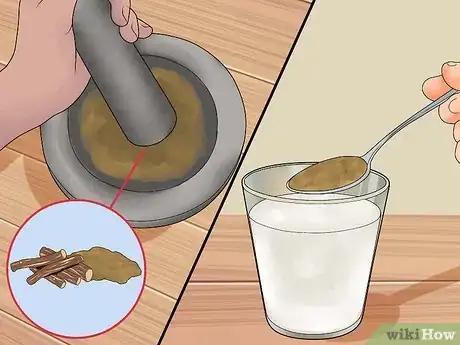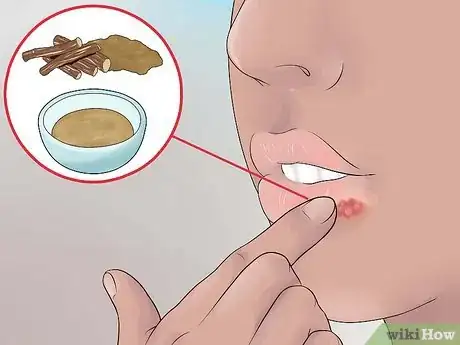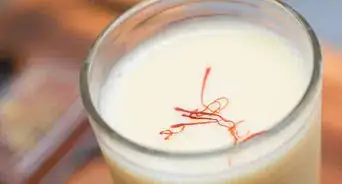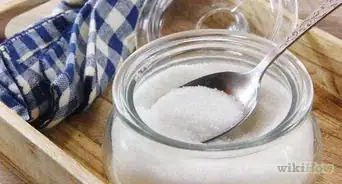This article was co-authored by wikiHow Staff. Our trained team of editors and researchers validate articles for accuracy and comprehensiveness. wikiHow's Content Management Team carefully monitors the work from our editorial staff to ensure that each article is backed by trusted research and meets our high quality standards.
There are 11 references cited in this article, which can be found at the bottom of the page.
wikiHow marks an article as reader-approved once it receives enough positive feedback. In this case, 87% of readers who voted found the article helpful, earning it our reader-approved status.
This article has been viewed 217,511 times.
Learn more...
Mulethi, more commonly known as licorice, is both a popular herbal supplement used to treat a variety of medical conditions, and an ingredient long popular in Asian and Middle Eastern cooking. Whether taken orally or used topically it has a variety of health benefits, some of which are traditional and some clinically proven, so long as it is taken in small doses for short periods of time. As an ingredient, it adds an herby anise and fennel flavor that work well in drinks, sweets, and savories alike.
Steps
Taking Mulethi Orally to Treat Medical Conditions
-
1Ingest mulethi to treat a variety of ailments. Mulethi, or licorice, has traditionally been used for arthritis, stomach ailments, and overly oily hair. Small or low-quality studies have shown licorice to have some effectiveness for:[1]
- The skin condition eczema
- Sore throats and mouth sores
- Reducing body fat
- Ulcers
-
2Gargle with a mulethi solution to treat sores and bad breath. Combined 1 tsp (5ml) or mulethi powder in 8 oz. (250ml) of lukewarm water and stir until the powder is completely dissolved.[2]
- Gargle this solution four to five times a day to help soothe and heal mouth sores. When used for mouth sores, this solution should not be swallowed.
- Similarly, gargling a solution made with 1/4 cup (60 ml) warm water and 1/2 tsp (2.5 ml) mulethi extract can help reduce or eliminate bad breath.
Advertisement -
3Drink mulethi tea for coughs or sore throat. Combine 1 Tbsp (15 ml) of crushed mulethi root with 2 cups (500 ml) of water in a small saucepan. Simmer the mixture on your stove over low heat for 15-20 minutes.[3] Filter before drinking.
- Drink the tea while still warm to help treat a cold, cough, or upper respiratory infection.
- Consume the tea once a day for a month to help heal acid reflux and peptic ulcers.
-
4Combine mulethi tea with other herbs to heighten effectiveness. Mulethi is believed to help increase the effectiveness of many other herbs when consumed simultaneously. You can blend mulethi with certain other herbal teas, and the conditions those teas may treat can become even more beneficial.
- Combine a ¼ cup of mulethi root with a 1-inch (2.5-cm) piece of ginger (sliced) and 2 quarts (2000 ml) of water. Bring to a boil, then lower heat and simmer for 10 minutes. Strain and drink while still warm. This particular blend can be used to treat colds, sore throat, and indigestion.
- Combine equal parts mulethi, chamomile, and peppermint. Use this mixture in a one-to-five ratio of herbs-to-water and steep over low heat for 10 minutes. Strain and drink as a way of treating indigestion and heartburn.
-
5Chew on a piece of mulethi to soothe a sore throat or fight bad breath. Cut off a piece of raw licorice and chew on it for 5 to 15 minutes.
- Licorice both numbs the throat and acts as a demulcent, coating your throat in a thin layer of mucus that soothes it.
- Licorice contains anti-bacterial compounds that fight the bacteria that cause cavities and bad breath.[4]
-
6Take licorice supplements for a variety of conditions. While teas and rinses are preferred for sore throats, mouth ailments, and indigestion due to their soothing effects, other conditions are best addressed by taking supplements in pill or extract form. Licorice supplements have anti-inflammatory, antioxidant, and antiviral effects that make them effective at treating low blood pressure, Addison's disease, infertility due to polycystic ovary syndrome, ulcers, indigestion, cancer (as a supplement), and immune disorders.
- Use DGL (Deglycyrrhizinated Licorice) if possible. It lacks the chemical glycyrrhizin, which can cause high blood pressure and muscle weakness.[5]
- The correct dose of non-DGL licorice is 2mg per kg of weight per day.
- WARNING: If your licorice is not DGL, do not take more than 100mg/day – approximately 1 ml of extract. Licorice overdose results in an excess of the hormone aldosterone, which can lead to muscle weakness, headaches, and high blood pressure.
-
7Be sure your licorice product contains actual licorice. In the U.S., it is common to use anise oil instead of licorice in many "licorice" products.
Using Mulethi Topically for Skin Ailments
-
1Note which conditions topical treatment might help. The topical application of mulethi is typically used to treat various skin conditions like eczema, but it can also be used to combat internal conditions with external manifestations (like cold sores), to improve one's overall energy, to treat melasma and lighten skin, and even to reduce the thickness of subcutaneous fat.
-
2Make a mulethi root salve. Place 2 tbsp (30 ml) of mulethi root in 6 cups (1500 ml) of water. Let it simmer over medium-low heat on the stove for 40 minutes. Strain and allow to cool. You can apply the resulting salve directly to the skin with a cotton pad.
-
3Soak in a mild mulethi solution to reduce fatigue and treat low blood pressure. Combine 3/4 cup (180 ml) crushed mulethi root and 4 cups (1 L) of warm water. Allow the mixture to rest for two to three hours, then boil it for 5 minutes. Mix the still hot solution into your bathwater and soak for 20-30 minutes.
-
4Make a paste with mulethi powder to fight acne, hair loss, or calluses. Purchase licorice powder, or grind down enough dried mulethi root to produce 1 Tbsp (15 ml). Combine this with 1/2 to 1 cup (125 to 250 ml) of cold milk, stirring well to form a thin paste.
- Add 1 tsp of honey to help fight acne. Honey has proven antimicrobial and healing properties.[8]
- Add 1/4 tsp (1.25 ml) of saffron to this paste and apply it to your scalp to help fight against hair loss.
- Add 1 tsp (5 ml) of olive oil instead of milk for a paste that will help to soften corns and calluses.
-
5Use mulethi extract for cold sores or genital herpes. You can use the extract much as you would the paste or salve. However, it is better for more focused applications, like cold sores. If you are going to used it over a broad area of skin, consider first diluting the extract.
- The glycyrrhizin in licorice extract has been shown to stop the reproduction of the virus that causes cold sores and genital herpes. Apply it directly to the sores twice a day.
Cooking with Mulethi
-
1Use mulethi to add flavor to a variety of dishes. Licorice, whether in root form or as a powder, can add notes of fennel and anise to any dish. You can use it for sweets, savories, sauces, and more.
-
2Make licorice syrup. A syrup made using boiled licorice roots can be poured over ice cream, cookies, or any other dessert to add a sweet licorice flavor. To make the syrup:[9]
- Peel and chop the root.
- Place in a pot, cover with water, and simmer for at least an hour.
- Add sugar – ¼ cup sugar per 4 cups of liquid. Bring to a simmer until sugar dissolves.
- Put in jars while still very hot.
-
3Steep licorice roots to add flavor to teas, syrups, sauces, and custards. Add the root to the tea, syrup, sauce, or custard you are preparing and heat. Let it steep for at least 10 minutes – the longer the more intense the flavor. Remove the root before serving.[10]
-
4Add flavor to sugar or salt cures. Licorice roots can be used a lot like vanilla pods to add subtle flavor to dried goods. Bury some in your sugar jar, or add the roots to salt and use it in cookies and puddings, or sprinkled on seafood, roasted carrots, or sweet potatoes.[11]
-
5Flavor your coffee with licorice. You can simply use a licorice root to stir your coffee (for a stronger flavor let it steep for a bit). Or for an even more powerful taste, add a dash of licorice powder to your cup of joe.[12]
-
6Include a pinch of powdered licorice in savory dishes. You can add powdered licorice straight to recipes. It works particularly well in meat rubs, and pairs well with pigeon, duck, quail, pork, and lamb.[13]
-
7Let licorice stand out in sweets. Licorice is a powerful flavor, so you'll want to make it the star ingredient in sweets. Try stirring it into batters or custards, or creating dishes that let it shine, like licorice ice cream or licorice panna cotta.
- For a list of some great licorice-flavored sweets, check out http://www.huffingtonpost.com/2013/04/15/licorice-flavored-recipes-desserts_n_3084184.html.
Expert Q&A
Did you know you can get expert answers for this article?
Unlock expert answers by supporting wikiHow
-
QuestionCan mulethi help me get fair skin?
 Zora Degrandpre, NDDr. Zora Degrandpre is a Natural Health Doctor and Licensed Naturopathic Physician in Vancouver, Washington. She is a grant reviewer for the National Institutes of Health and the National Center for Complementary and Alternative Medicine. She received her ND from the National College of Natural Medicine in 2007.
Zora Degrandpre, NDDr. Zora Degrandpre is a Natural Health Doctor and Licensed Naturopathic Physician in Vancouver, Washington. She is a grant reviewer for the National Institutes of Health and the National Center for Complementary and Alternative Medicine. She received her ND from the National College of Natural Medicine in 2007.
Natural Health Doctor
Warnings
- Licorice interacts with many medications. Always consult your doctor before taking mulethi for medicinal purposes.⧼thumbs_response⧽
- Do not take mulethi for more than four weeks unless instructed otherwise by your doctor. Consuming 100mg or more for prolonged periods can drastically increase blood pressure and lower potassium levels in otherwise healthy people. If you suffer from heart disease, kidney disease, or high blood pressure, even small amounts can cause complications.[14]⧼thumbs_response⧽
- Do not take mulethi during pregnancy. High consumption can cause miscarriage or early delivery. Little is known about the effects of mulethi during nursing, so it is recommended that you avoid it during this stage, as well.⧼thumbs_response⧽
- Stop taking mulethi at least two weeks before a scheduled surgery since it can affect your body's blood pressure control.⧼thumbs_response⧽
References
- ↑ https://www.mountsinai.org/health-library/herb/licorice
- ↑ https://www.sciencedirect.com/science/article/pii/S0975947617305107
- ↑ https://www.mountsinai.org/health-library/herb/licorice
- ↑ https://www.ncbi.nlm.nih.gov/pmc/articles/PMC4148569/
- ↑ http://www.ncbi.nlm.nih.gov/pmc/articles/PMC3498851/
- ↑ http://www.ncbi.nlm.nih.gov/pubmed/14522625
- ↑ http://www.ncbi.nlm.nih.gov/pmc/articles/PMC2769151/
- ↑ http://www.ncbi.nlm.nih.gov/pmc/articles/PMC3609166/
- ↑ http://cooking.stackexchange.com/questions/43616/making-licorice-root-syrup-or-extract
- ↑ http://www.greatbritishchefs.com/how-to-cook/how-to-cook-with-liquorice
- ↑ http://food52.com/blog/11543-5-ways-to-use-a-spent-vanilla-bean-pod
- ↑ https://www.foodandwine.com/news/licorice-invading-americas-coffee-shops-and-restaurants
- ↑ http://www.greatbritishchefs.com/how-to-cook/how-to-cook-with-liquorice
- ↑ http://www.ncbi.nlm.nih.gov/pmc/articles/PMC3498851/
About This Article
To use mulethi, which is also called licorice, try making a tea with some of the crushed root to help with coughs, stomach aches, or sore throats. You can also take mulethi as a dietary supplement to treat low blood pressure, ulcers, and immune disorders, since it has antiviral and antioxidant properties. Alternatively, add it to recipes where you’d like a strong licorice flavor. For example, try steeping a piece of mulethi root in tea or adding powdered mulethi to spice rubs. For tips on how to make your own mulethi syrup to add to drinks and recipes, read on!











































































Medical Disclaimer
The content of this article is not intended to be a substitute for professional medical advice, examination, diagnosis, or treatment. You should always contact your doctor or other qualified healthcare professional before starting, changing, or stopping any kind of health treatment.
Read More...